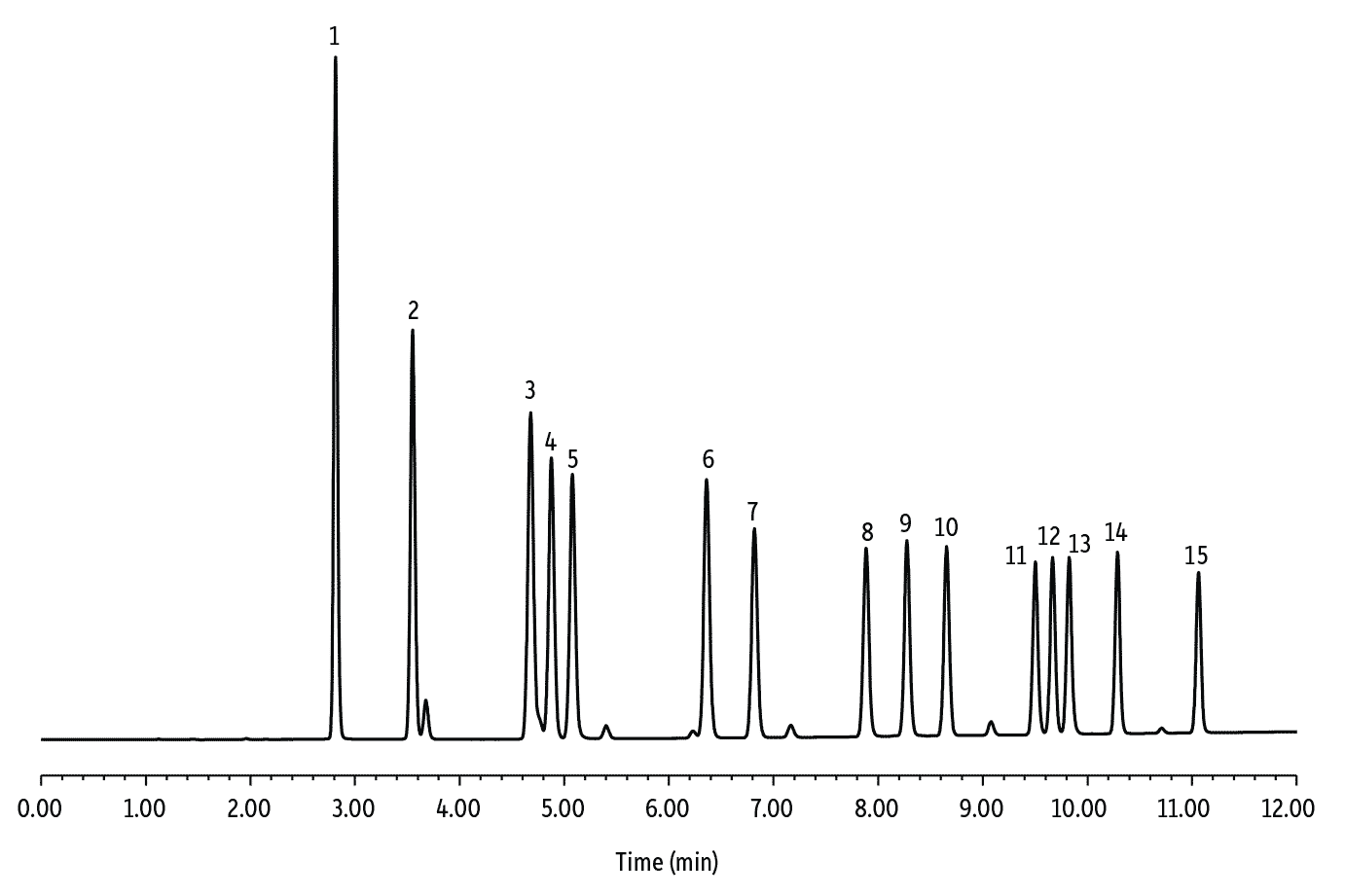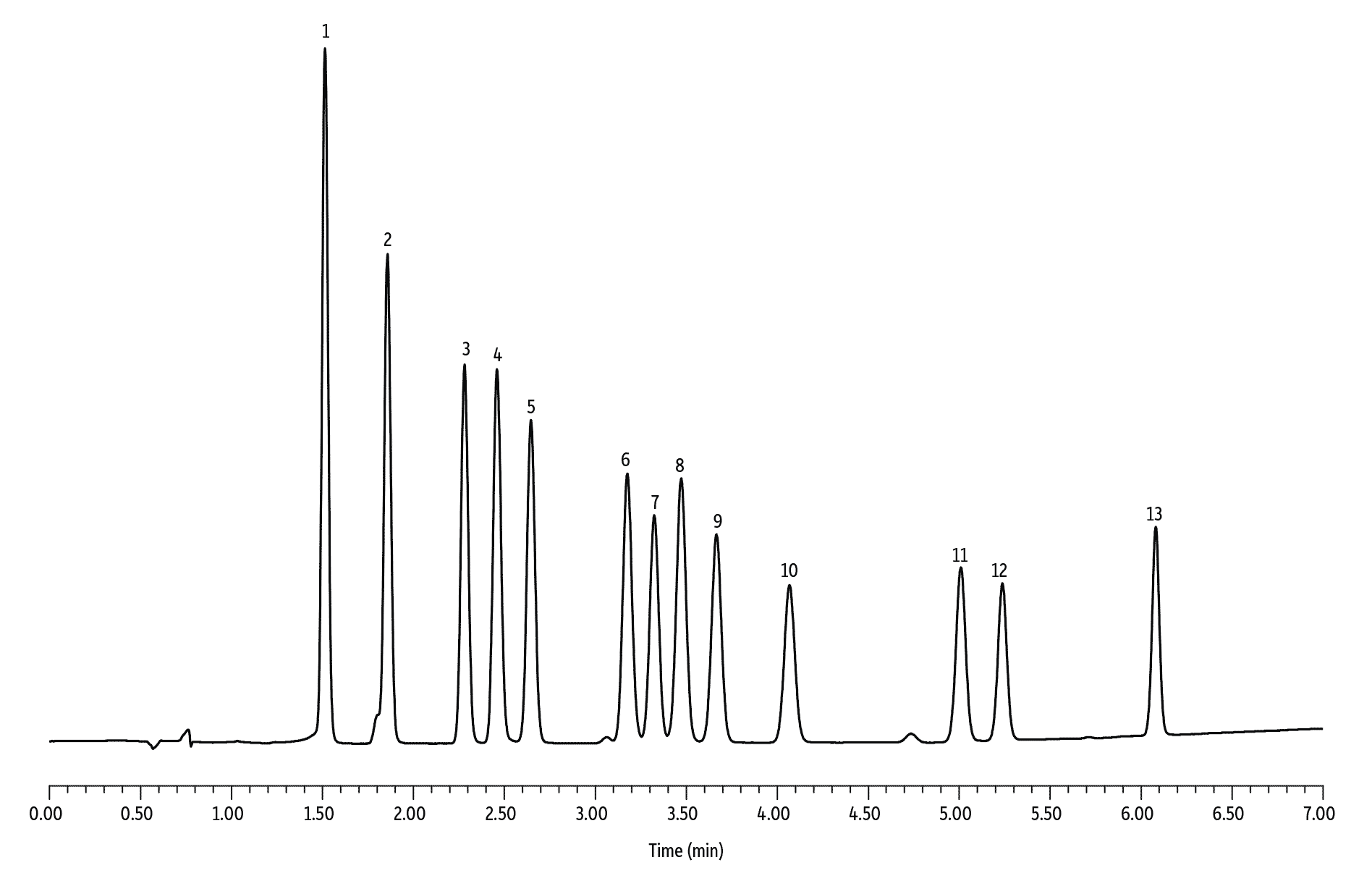Improve Analysis of Aldehydes and Ketones in Air Samples with Faster, More Accurate Methodology
Featured Application: Aldehydes and Ketones in Air Samples on Raptor ARC-18 and C18 LC Columns

- Baseline separation ensures accurate determination of 15 commonly analyzed aldehydes and ketones in air samples.
- Raptor LC columns give you results in minutes—not hours—for increased sample throughput.
- Restek certified reference materials are specially formulated for ambient air and automotive emissions testing.
Accurate analysis of aldehydes and ketones in air samples is an important part of monitoring programs that are used to control air pollution and to protect human health around the world. These airborne carbonyls from industrial and vehicle emissions are precursors to ozone in smog and are associated with respiratory and pulmonary problems. In addition, specific carbonyls—formaldehyde and acetaldehyde—have been identified as known or suspected carcinogens. Prior to analysis, aldehydes and ketones are converted to hydrazone derivatives when they are captured on a sampling tube composed of silica gel coated with 2,4-dinitrophenylhydrazine (DNPH). Then, the aldehyde/ketone DNPH derivatives are eluted from the sampling tube with solvent and analyzed by HPLC-UV. Typically, carbonyl LC methods require long analysis times (often over an hour), but many still fail to provide adequate resolution for some aldehyde/ketone DNPH derivatives.
To help labs improve analytical speed and accuracy in the analysis of aldehydes and ketones in air samples, Restek has developed LC columns, instrument conditions, and certified reference materials that reliably provide baseline separation of commonly analyzed aldehyde/ketone DNPH derivatives in just minutes. For example, airborne carbonyls LC method U.S. EPA Method TO-11A uses a conventional C18 column and requires an analysis time of over one hour, yet acrolein and acetone partially coelute and the o-, m-, and p- tolualdehyde isomers cannot be fully separated. In contrast, using a Raptor C18 column under the conditions shown below, all 15 carbonyls—including the tolualdehyde isomer cluster—are separated to baseline in a fast 14-minute analysis.
Similarly, airborne carbonyl LC method CARB 1004 produces extremely long analysis times; in fact, this method requires two separate chromatographic analyses in order to quantify all compounds. The first is a 37-minute analysis using two columns connected in series. Even with two columns and a long analysis time, methyl ethyl ketone and butyraldehyde coelute in this analysis. To report these two compounds, another 30-minute chromatographic analysis with a different column is needed. However, this second analysis cannot be used to report all compounds due to the coelution of formaldehyde with a non-carbonyl compound. This same list of CARB 1004 aldehyde/ketone DNPH derivatives can be fully resolved by the second Restek method shown below using a Raptor ARC-18 column in a fast 8.5-minute analysis—an 8-fold reduction in analysis time with a single column.
Both of these methods from Restek are compatible with conventional 400 bar HPLC systems and benefit from the larger, low-clog frit used in Raptor column hardware. Using either Raptor LC column—along with Restek’s airborne carbonyl reference standards—assures fast, accurate analysis of aldehydes and ketones in air and offers an opportunity for improved sample throughput compared to typical columns and methods.
 LC_EV0532
LC_EV0532
| Raptor C18 (cat.# 9304A65) |
| 150 mm x 4.6 mm ID |
| 2.7 µm |
| 90 Å |
|
| 30 °C |
| Acetonitrile |
| 15 µg/mL |
|
| 2 µL |
| Water |
| Methanol:acetonitrile (650:50)* |
| | Time (min) | Flow (mL/min) | %A | %B |
|---|
| 0.00 | 0.8 | 30 | 70 | | 5.00 | 0.8 | 25 | 75 | | 11.00 | 0.8 | 10 | 90 | | 11.01 | 0.8 | 0 | 100 | | 12.00 | 0.8 | 0 | 100 | | 12.01 | 0.8 | 30 | 70 | | 14.00 | 0.8 | 30 | 70 |
|
 LC_EV0529
LC_EV0529
| Raptor ARC-18 (cat.# 9314A1E) |
| 100 mm x 3.0 mm ID |
| 2.7 µm |
|
| 40 °C |
| Acetonitrile |
| 3 µg/mL |
|
| 3 µL |
| Water:tetrahydrofuran (5:2) |
| Acetonitrile |
| | Time (min) | Flow (mL/min) | %A | %B |
|---|
| 0.00 | 0.6 | 70 | 30 | | 3.5 | 0.6 | 65 | 35 | | 6.5 | 0.6 | 30 | 70 | | 6.51 | 0.6 | 70 | 30 | | 8.5 | 0.6 | 70 | 30 |
|
| 240 bar |
EVSS2393A-UNV



